
A mycorrhiza is a symbiotic association between a fungus and a plant. The term mycorrhiza refers to the role of the fungus in the plant's rhizosphere, its root system. Mycorrhizae play important roles in plant nutrition, soil biology, and soil chemistry.

The Boletaceae are a family of mushroom-forming fungi, primarily characterised by small pores on the spore-bearing hymenial surface, instead of gills as are found in most agarics. Nearly as widely distributed as the agarics, the family is renowned for hosting some prime edible species highly sought after by mushroom hunters worldwide, such as the cep or king bolete . A number of rare or threatened species are also present in the family, that have become the focus of increasing conservation concerns. As a whole, the typical members of the family are commonly known as boletes.

The Russulaceae are a diverse family of fungi in the order Russulales, with roughly 1,900 known species and a worldwide distribution. They comprise the brittlegills and the milk-caps, well-known mushroom-forming fungi that include some edible species. These gilled mushrooms are characterised by the brittle flesh of their fruitbodies.

An arbuscular mycorrhiza (AM) is a type of mycorrhiza in which the symbiont fungus penetrates the cortical cells of the roots of a vascular plant forming arbuscules. Arbuscular mycorrhiza is a type of endomycorrhiza along with ericoid mycorrhiza and orchid mycorrhiza. They are characterized by the formation of unique tree-like structures, the arbuscules. In addition, globular storage structures called vesicles are often encountered.
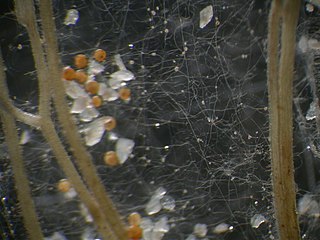
Glomeromycota are one of eight currently recognized divisions within the kingdom Fungi, with approximately 230 described species. Members of the Glomeromycota form arbuscular mycorrhizas (AMs) with the thalli of bryophytes and the roots of vascular land plants. Not all species have been shown to form AMs, and one, Geosiphon pyriformis, is known not to do so. Instead, it forms an endocytobiotic association with Nostoc cyanobacteria. The majority of evidence shows that the Glomeromycota are dependent on land plants for carbon and energy, but there is recent circumstantial evidence that some species may be able to lead an independent existence. The arbuscular mycorrhizal species are terrestrial and widely distributed in soils worldwide where they form symbioses with the roots of the majority of plant species (>80%). They can also be found in wetlands, including salt-marshes, and associated with epiphytic plants.

The Polyporaceae are a family of poroid fungi belonging to the Basidiomycota. The flesh of their fruit bodies varies from soft to very tough. Most members of this family have their hymenium in vertical pores on the underside of the caps, but some of them have gills or gill-like structures. Many species are brackets, but others have a definite stipe – for example, Polyporus badius.
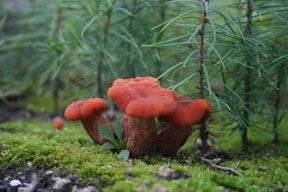
Laccaria bicolor is a small tan-colored mushroom with lilac gills. It is edible but not choice, and grows in mixed birch and pine woods. It is found in the temperate zones of the globe, in late summer and autumn. L. bicolor is an ectomycorrhizal fungus used as a soil inoculant in agriculture and horticulture.
Glomus aggregatum is an arbuscular mycorrhizal fungus used as a soil inoculant in agriculture and horticulture. Like other species in this phylum it forms obligate symbioses with plant roots, where it obtains carbon (photosynthate) from the host plant in exchange for nutrients and other benefits.
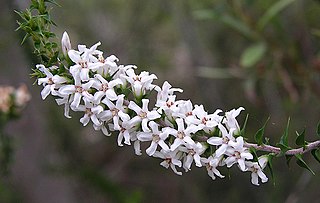
The ericoid mycorrhiza is a mutualistic relationship formed between members of the plant family Ericaceae and several lineages of mycorrhizal fungi. This symbiosis represents an important adaptation to acidic and nutrient poor soils that species in the Ericaceae typically inhabit, including boreal forests, bogs, and heathlands. Molecular clock estimates suggest that the symbiosis originated approximately 140 million years ago.

Hydnellum is a genus of tooth fungi in the family Bankeraceae. Widely distributed in the Northern Hemisphere, the genus contains around 40 species. The fruitbodies of its members grow by slowly enveloping nearby bits of grass and vegetation. There is great variability in the form of Hydnellum fruitbodies, which are greatly influenced by environmental conditions such as rainfall and humidity, drying winds, and temperature. They are too tough and woody to eat comfortably. Several species have become the focus of increasing conservation concern following widespread declines in abundance.
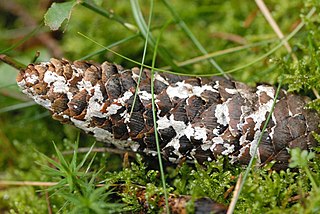
Atheliaceae is a family of mostly corticioid fungi placed in the order Atheliales. Both the order and the family were described by the Swiss mycologist Walter Jülich in 1981 along with three other families, Lobuliciaceae, Byssocorticiaceae, Pilodermataceae and Tylosporaceae discovered in 2020. According to a 2008 estimate, the family contains 20 genera and approximately 100 species. However, many genera formerly considered to belong in the Atheliaceae have since been moved to other families, including Amylocorticiaceae, Albatrellaceae, and Hygrophoraceae. Despite being a relatively small group with inconspicuous forms, Atheliaceae members show great diversity in life strategies and are widespread in distribution. Additionally, being a group strictly composed of largely corticioid fungi, they may also provide insights on the evolution of fruiting body forms in basidiomycetes.

The Phanerochaetaceae are a family of mostly crust fungi in the order Polyporales.

Phellodon is a genus of tooth fungi in the family Bankeraceae. Species have small- to medium-sized fruitbodies with white spines on the underside from which spores are released. All Phellodon have a short stalk or stipe, and so the genus falls into the group known as stipitate hydnoid fungi. The tough and leathery flesh usually has a pleasant, fragrant odor, and develops a cork-like texture when dry. Neighboring fruitbodies can fuse, sometimes producing large mats of joined caps. Phellodon species produce a white spore print, while the individual spores are roughly spherical to ellipsoid in shape, with spiny surfaces.

Metarhizium flavoviride is a Sordariomycete in the order Hypocreales and family Clavicipitaceae. The genus Metarhizium currently consists of over 70 described species and are a group of fungal isolates that are known to be virulent against Hemiptera and some Coleoptera. M. flavoviride is described as its own species, but there also exists a variety of M. flavoviride, which is M. flavoviride var. flavoviride. Previously described varieties of M. flavoviride have been documented, however recent random amplified polymorphic DNA (RAPD) markers have assigned these varieties as new species. The reassigned species are as follows: M. flavoviride Type E is now M. brasiliense; M. flavoviride var. minus is now M. minus; M. flavoviride var. novozealandicum is now M. novozealandicum; and M. flavoviride var. pemphigi is now M. pemphigi.

Rhizoctonia is a genus of fungi in the order Cantharellales. Species form thin, effused, corticioid basidiocarps, but are most frequently found in their sterile, anamorphic state. Rhizoctonia species are saprotrophic, but some are also facultative plant pathogens, causing commercially important crop diseases. Some are also endomycorrhizal associates of orchids. The genus name was formerly used to accommodate many superficially similar, but unrelated fungi.
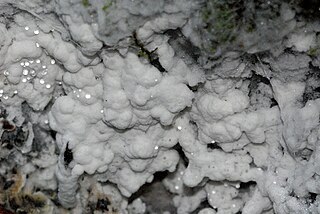
Atheliales is an order of mostly corticioid or athelioid fungi placed under the Agaricomycetidae subclass. It was first described by Walter Jülich in 1981 along with 4 families, Lobuliciaceae, Atheliaceae, Byssocorticiaceae and Pilodermataceae. Another family was discovered in 2020 called Tylosporaceae. It contains roughly 100 described species in 20 genera with varied ecological diversity. Most species have relatively simple gross morphology and do not have a lot of diagnostic characters. They produce crust-like fruiting bodies attached loosely to their substrate.

Tulasnella is a genus of effused (patch-forming) fungi in the order Cantharellales. Basidiocarps, when visible, are typically smooth, ceraceous (waxy) to subgelatinous, frequently lilaceous to violet-grey, and formed on the underside of fallen branches and logs. They are microscopically distinct in having basidia with grossly swollen sterigmata on which basidiospores are formed. One atypical species, Tulasnella aurantiaca, produces orange to red, gelatinous, pustular anamorphs on wood. Some species form facultative mycorrhizas with orchids and liverworts. Around 80 species of Tulasnella are known worldwide.

An ectomycorrhiza is a form of symbiotic relationship that occurs between a fungal symbiont, or mycobiont, and the roots of various plant species. The mycobiont is often from the phyla Basidiomycota and Ascomycota, and more rarely from the Zygomycota. Ectomycorrhizas form on the roots of around 2% of plant species, usually woody plants, including species from the birch, dipterocarp, myrtle, beech, willow, pine and rose families. Research on ectomycorrhizas is increasingly important in areas such as ecosystem management and restoration, forestry and agriculture.
Ambispora granatensis is an arbuscular mycorrhizal fungal species in the genus Ambispora, family Ambisporaceae. It forms spores of the acaulosporois and glomoid morphs, thus the Ambispora classification. It was discovered in Granada Spain in 2010 and has unique spore characteristics, which distinguishes the species from the others in its genus.
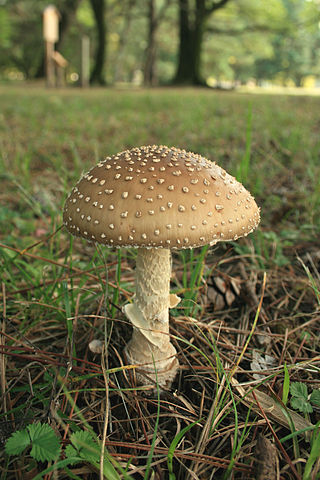
Symbiomycota is a clade of fungi containing both Glomeromycota and Dikarya. It is supported with RNA analysis.

















